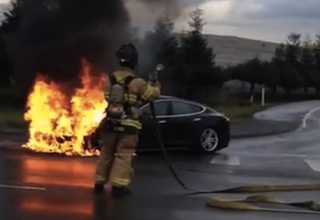The recent incident of a Tesla Model S all-electric vehicle catching fire is renewing questions about the safety of lithium-ion batteries and their use in transportation applications. 
The Tesla story is the second high-profile case this year, the other involving Boeing’s 787 Dreamliner, both of which involve incidents with lithium-ion batteries. The cases are shining a spotlight on the use of lithium-ion batteries in transportation and the challenges designers face in minimizing the risks of battery failure. Is this technology robust and mature enough to be used extensively in transportation applications (such as airplanes and automobiles) while not posing any elevated safety risks?
For right now, the main strategy appears to be one of recognizing the underlying failure mechanism of lithium-ion battery cells and dealing with this possible failure through containment. This white paper from UL provides a lot of good information on the testing procedures for lithium-ion batteries, including a discussion of the problem of internal short circuits, which is the main mechanism for failure in these kinds of batteries.
The solution implemented by Boeing on its 787 Dreamliner indicates that the underlying problem of battery fires may not have been resolved, only contained with a stainless steel battery box to quench any potential fires and contain them within the box, preventing them from spreading and causing larger fires and more damage.
And at least one company is offering a containment solution in which any internal short circuits in batteries are allowed to smolder and extinguish rather than ignite and explode.


Leave a Reply
You must be logged in to post a comment.